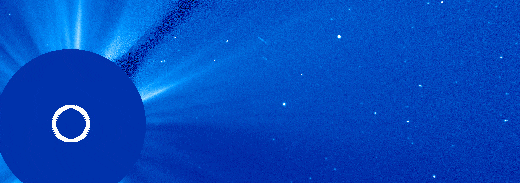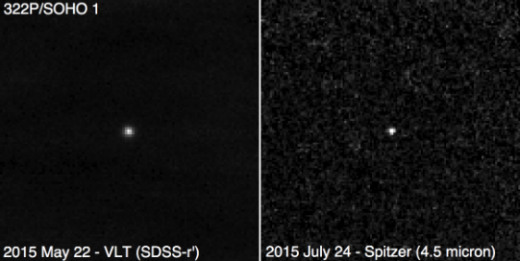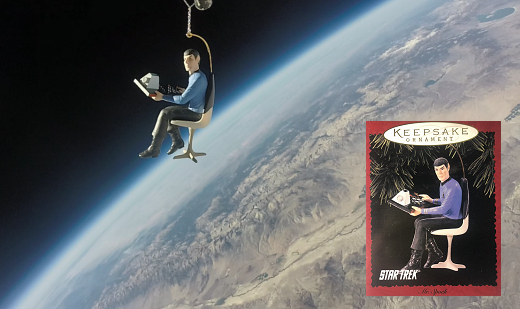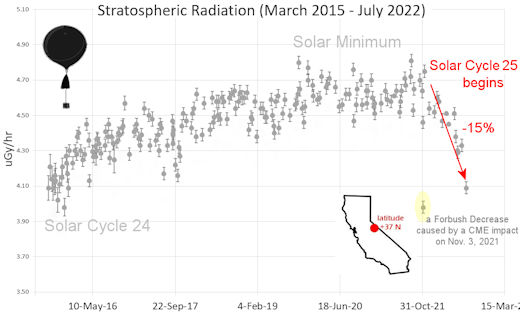This is an AI Free Zone! Text created by ChatGPT and other Large Language Models is spreading rapidly across the Internet. It's well-written, artificial, frequently inaccurate. If you find a mistake on Spaceweather.com, rest assured it was made by a real human being. | | |
QUIET WEEKEND--THE THIRD IN A ROW: The sun has not produced an X-flare in almost 3 weeks--a remarkable gap for active Solar Cycle 25. The quiet will probably continue this weekend. There is a slight chance of M-class flares from sunspot AR3415, but a category X explosion would be a surprise given the magnetic simplicity of every other sunspot on the solar disk. Solar flare alerts: SMS Text
A WEIRD COMET JUST BUZZEDTHE SUN: Citizen scientists watching SOHO's coronagraph feed on Aug. 21st weren't sure what they had just seen. A point-like object emerged from the glare of the sun, quickly reversed course, then headed back from where it came. Time to call a Congressional hearing? See for yourself:

In fact, this was no UFO. It is a weird comet named "322P." Every 3.9 years it buzzes the sun, making such a tight turn inside the orbit of Mercury that it looks like something is breaking the laws of physics. The fact that the comet has no tail, not even when it is being blasted by maximum solar heat, adds to its vibe of mystery.
"This is a very interesting object," says Karl Battams of the US Naval Research Lab's Solar and Heliospheric Physics Branch. "We are actively studying it, trying to learn what it is."
Comet 322P has been discovered in SOHO coronagraph images at least three times before: 1999, 2003 and 2007. Eventually astronomers realized all three were the same object. Over the years, SOHO has found more than 4500 comets diving into the sun and disintegrating. This was SOHO's first discovery of a *periodic* comet that routinely survives its close encounters.
In 2015, a team of astronomers led by Matthew Knight tracked the comet as it receded from the sun using the Very Large Telescope in Chile and NASA's infrared Spitzer Space Telescope. They were looking for signs of a tail or other outgassing typical of comets. However, 322P remained pointlike and inscrutable:

"322P appeared inactive in all images," they wrote. "Our results suggest that it may be of asteroidal origin and only active in the SOHO fields of view via processes different from the volatile-driven activity of traditional comets."
According to their data, 322P is a dense object (1000 kg/m^3), measuring 150 to 320 meters in diameter, which spins every 2.8 hours. Its incredibly tough, losing no detectable mass when it approaches the sun. The researchers speculate that it may be an extinct comet, so thoroughly sun-baked that only an impervious skeleton of rock and metal remains.
"We still have lots to learn about the small bodies in our solar system," says Battams. "322P is a fabulous example of one such quirky object."
Realtime Space Weather Photo Gallery
Free: Spaceweather.com Newsletter
RARE MR. SPOCK ORNAMENT: Planning ahead for Christmas is only logical. Decorate your tree with a rare Mr. Spock ornament! The students of Earth to Sky Calculus launched this one to the stratosphere onboard a cosmic ray research balloon:

You can have it for $129.95. The students are selling Spock ornaments to pay the helium bill for their cosmic ray ballooning program. Made by Hallmark in the 1990s, the ornament comes with a greeting card showing the science officer in flight and telling the story of its trip to the stratosphere and back again.
Far Out Gifts: Earth to Sky Store
All sales support hands-on STEM education
Realtime Aurora Photo Gallery
Free: Spaceweather.com Newsletter
Every night, a network of
NASA all-sky cameras scans the skies above the United States for meteoritic fireballs. Automated software maintained by NASA's Meteoroid Environment Office calculates their orbits, velocity, penetration depth in Earth's atmosphere and many other characteristics. Daily results are presented here on Spaceweather.com.
On Aug 25, 2023, the network reported 4 fireballs.
(4 sporadics)

In this diagram of the inner solar system, all of the fireball orbits intersect at a single point--Earth. The orbits are color-coded by velocity, from slow (red) to fast (blue). [Larger image] [movies]
Potentially Hazardous Asteroids (
PHAs) are space rocks larger than approximately 100m that can come closer to Earth than 0.05 AU. None of the known PHAs is on a collision course with our planet, although astronomers are finding
new ones all the time.
On August 26, 2023 there were 2349 potentially hazardous asteroids.
 |
Recent & Upcoming Earth-asteroid encounters: | Asteroid | Date(UT) | Miss Distance | Velocity (km/s) | Diameter (m) |
| 2023 QE | 2023-Aug-21 | 8.7 LD | 6.5 | 12 |
| 2023 PM1 | 2023-Aug-21 | 8.2 LD | 18.6 | 68 |
| 2023 QB1 | 2023-Aug-21 | 1.8 LD | 11.3 | 6 |
| 2023 QO5 | 2023-Aug-22 | 1.4 LD | 8.3 | 15 |
| 2023 PM | 2023-Aug-22 | 9.5 LD | 7 | 55 |
| 2023 QZ | 2023-Aug-22 | 13.5 LD | 4.5 | 15 |
| 2023 QU1 | 2023-Aug-22 | 16.4 LD | 5.7 | 21 |
| 6037 | 2023-Aug-23 | 15.9 LD | 14.3 | 571 |
| 2023 QW | 2023-Aug-23 | 4.2 LD | 16.3 | 23 |
| 2023 QO | 2023-Aug-23 | 6.5 LD | 8.8 | 15 |
| 2023 QF | 2023-Aug-23 | 1.9 LD | 5.4 | 12 |
| 2023 QS2 | 2023-Aug-23 | 12.6 LD | 17.6 | 33 |
| 2023 QN2 | 2023-Aug-24 | 19.1 LD | 15.4 | 42 |
| 2023 QK2 | 2023-Aug-24 | 7.7 LD | 4.9 | 16 |
| 2023 QG4 | 2023-Aug-25 | 6.6 LD | 24 | 105 |
| 2023 QC2 | 2023-Aug-25 | 9.2 LD | 10.2 | 21 |
| 2023 QT1 | 2023-Aug-26 | 11.5 LD | 10.6 | 33 |
| 2007 RR17 | 2023-Aug-26 | 8.3 LD | 7.1 | 63 |
| 2023 QR1 | 2023-Aug-27 | 4.3 LD | 5 | 13 |
| 2023 QQ | 2023-Aug-27 | 10.7 LD | 10.1 | 25 |
| 2023 QJ5 | 2023-Aug-27 | 4.6 LD | 12.2 | 14 |
| 2023 QK5 | 2023-Aug-29 | 3.9 LD | 6.8 | 12 |
| 2023 QD2 | 2023-Aug-29 | 3.3 LD | 7.8 | 15 |
| 2012 PZ17 | 2023-Aug-30 | 16.8 LD | 3.6 | 16 |
| 2023 QH | 2023-Aug-31 | 12 LD | 15.9 | 63 |
| 2023 QB2 | 2023-Sep-01 | 8.1 LD | 7.2 | 21 |
| 2023 QZ1 | 2023-Sep-01 | 18.2 LD | 18.6 | 51 |
| 2023 QU | 2023-Sep-01 | 13.6 LD | 9.8 | 34 |
| 2017 BY32 | 2023-Sep-02 | 16.4 LD | 3.5 | 19 |
| 2023 QG | 2023-Sep-03 | 11.6 LD | 13.7 | 75 |
| 2023 QH1 | 2023-Sep-03 | 13.1 LD | 6.4 | 23 |
| 2021 JA5 | 2023-Sep-06 | 13.3 LD | 10.9 | 19 |
| 2023 QC5 | 2023-Sep-08 | 10.6 LD | 7.6 | 27 |
| 2020 GE | 2023-Sep-08 | 14.9 LD | 1.4 | 8 |
| 2023 QF6 | 2023-Sep-10 | 7 LD | 10.5 | 22 |
| 2020 RT2 | 2023-Sep-12 | 11 LD | 10 | 8 |
| 2016 LY48 | 2023-Sep-16 | 5 LD | 10.8 | 99 |
| 2010 TE | 2023-Sep-16 | 6.8 LD | 6 | 22 |
| 523598 | 2023-Sep-20 | 19.8 LD | 25 | 239 |
| 2019 SF6 | 2023-Sep-26 | 16.7 LD | 8.6 | 20 |
| 2013 TG6 | 2023-Sep-28 | 3.6 LD | 4.1 | 17 |
| 2009 UG | 2023-Sep-30 | 6.1 LD | 9 | 78 |
| 349507 | 2023-Oct-03 | 16.5 LD | 21 | 696 |
| 2022 FX1 | 2023-Oct-04 | 20 LD | 9.9 | 25 |
| 2022 TD | 2023-Oct-07 | 8.9 LD | 9.4 | 10 |
| 2018 ER1 | 2023-Oct-08 | 12.5 LD | 5.3 | 27 |
| 2022 UX1 | 2023-Oct-11 | 3.1 LD | 8.6 | 9 |
| 2015 KW120 | 2023-Oct-12 | 18.2 LD | 13 | 22 |
| 2021 NT14 | 2023-Oct-13 | 18.6 LD | 8.6 | 254 |
| 2011 GA | 2023-Oct-15 | 6.8 LD | 16.6 | 230 |
| 2007 SQ6 | 2023-Oct-15 | 19.4 LD | 6.5 | 130 |
| 2019 UZ3 | 2023-Oct-16 | 9.6 LD | 8.3 | 14 |
| 1998 HH49 | 2023-Oct-17 | 3.1 LD | 14.8 | 193 |
| 2022 UO10 | 2023-Oct-19 | 7.8 LD | 9.8 | 16 |
| 2020 UR | 2023-Oct-20 | 5.8 LD | 12.9 | 9 |
| 2020 FM6 | 2023-Oct-23 | 15.5 LD | 15.9 | 149 |
| 2019 HH4 | 2023-Oct-24 | 13.3 LD | 20 | 365 |
Notes: LD means "Lunar Distance." 1 LD = 384,401 km, the distance between Earth and the Moon. 1 LD also equals 0.00256 AU. | | Cosmic Rays in the Atmosphere |
SPACE WEATHER BALLOON DATA: Almost once a week, Spaceweather.com and the students of Earth to Sky Calculus fly space weather balloons to the stratosphere over California. These balloons are equipped with sensors that detect secondary cosmic rays, a form of radiation from space that can penetrate all the way down to Earth's surface. Our monitoring program has been underway without interruption for 7 years, resulting in a unique dataset of in situ atmospheric measurements.
Latest results (July 2022): Atmospheric radiation is decreasing in 2022. Our latest measurements in July 2022 registered a 6-year low:

What's going on? Ironically, the radiation drop is caused by increasing solar activity. Solar Cycle 25 has roared to life faster than forecasters expected. The sun's strengthening and increasingly tangled magnetic field repels cosmic rays from deep space. In addition, solar coronal mass ejections (CMEs) sweep aside cosmic rays, causing sharp reductions called "Forbush Decreases." The two effects blend together to bring daily radiation levels down.
.Who cares? Cosmic rays are a surprisingly "down to Earth" form of space weather. They can alter the chemistry of the atmosphere, trigger lightning, and penetrate commercial airplanes. According to a study from the Harvard T.H. Chan school of public health, crews of aircraft have higher rates of cancer than the general population. The researchers listed cosmic rays, irregular sleep habits, and chemical contaminants as leading risk factors. A number of controversial studies (#1, #2, #3, #4) go even further, linking cosmic rays with cardiac arrhythmias and sudden cardiac death.
Technical notes: The radiation sensors onboard our helium balloons detect X-rays and gamma-rays in the energy range 10 keV to 20 MeV. These energies span the range of medical X-ray machines and airport security scanners.
Data points in the graph labeled "Stratospheric Radiation" correspond to the peak of the Regener-Pfotzer maximum, which lies about 67,000 feet above central California. When cosmic rays crash into Earth's atmosphere, they produce a spray of secondary particles that is most intense at the entrance to the stratosphere. Physicists Eric Regener and Georg Pfotzer discovered the maximum using balloons in the 1930s and it is what we are measuring today.
| | The official U.S. government space weather bureau |
| | The first place to look for information about sundogs, pillars, rainbows and related phenomena. |
| | Researchers call it a "Hubble for the sun." SDO is the most advanced solar observatory ever. |
| | 3D views of the sun from NASA's Solar and Terrestrial Relations Observatory |
| | Realtime and archival images of the Sun from SOHO. |
| | information about sunspots based on the latest NOAA/USAF Active Region Summary |
| | current counts of failed and deployed Starlink satellites from Jonathan's Space Page |
| | Authoritative predictions of space junk and satellite re-entries |
| | from the NOAA Space Environment Center |
| | fun to read, but should be taken with a grain of salt! Forecasts looking ahead more than a few days are often wrong. |
| | from the NOAA Space Environment Center |
| | the underlying science of space weather |
 | Getting YouTube comments is essential if you want to beat the algorithm! That’s why you need to buy YouTube comments from RealSocialz.com because they offer real USA comments you can customize. |
 | When looking for casinos to play online when the weather is bad, you can try casino online trucchi for Italian games. If you are not from Finland you can try the Swedish page Svenska casino online to find suitable games, check out svenskacasinoonline.net. Always check your local laws before playing with real money. |
 | BestCSGOGambling is the best site for everything related to CSGO gambling on the web |
| | These links help Spaceweather.com stay online. Thank you to our supporters! |
| | | | | | |

